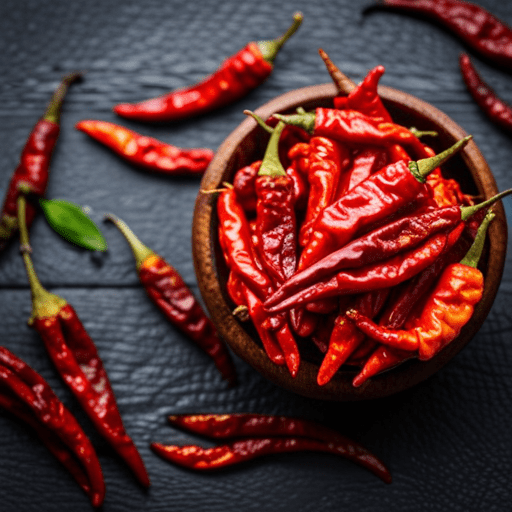Dried Chilli Pepper
Dried Chilli Pepper
Introduction to Dried Chilli Pepper
Dried chilli pepper, also known as chili powder or red pepper flakes, is a widely used spice that adds heat and flavor to various dishes. It is made from drying fresh chilli peppers and crushing them into a powder or flakes. This process enhances the flavor and heat of the chillies, making them a popular ingredient in many cuisines around the world.
History and Origins
Chilli peppers have a rich history that dates back thousands of years. They are believed to have originated in Central and South America, where they were cultivated by ancient civilizations such as the Aztecs and Mayans. These cultures used chilli peppers not only as a spice but also for medicinal purposes.
Chilli peppers were introduced to Europe in the late 15th century by Christopher Columbus. From there, they spread to various parts of the world through trade routes established during the Age of Exploration.
Types of Dried Chilli Pepper
There is a wide variety of dried chilli peppers available, each with its unique flavor profile and heat level. Some popular types include:
1. Ancho: This mild dried chilli pepper has a sweet and smoky flavor, often used in Mexican dishes like mole sauce.
2. Cayenne: Known for its fiery heat, cayenne pepper is commonly used in spicy dishes and hot sauces.
3. Habanero: With its intense heat and fruity taste, habanero is one of the hottest dried chillies used in cooking.
4. Paprika: Made from dried and ground red peppers, paprika adds both color and mild flavor to dishes.
5. Chipotle: These dried and smoked jalapeno peppers have a distinctive smoky flavor, perfect for adding depth to barbecue sauces and stews.
Health Benefits of Dried Chilli Pepper
Dried chilli peppers not only add flavor to your meals but also offer several health benefits. They contain a compound called capsaicin, which is responsible for their spicy heat and has been shown to have numerous health advantages. Some of the potential benefits include:
1. Pain relief : Capsaicin has analgesic properties that can help alleviate pain, particularly in conditions like arthritis and muscle soreness.
2. Weight management: The heat generated by capsaicin increases metabolism and may aid in weight loss by boosting calorie burning.
3. Heart health: Studies suggest that regular consumption of chilli peppers may lower blood pressure and reduce the risk of heart disease.
4.Digestive health: Dried chilli peppers can stimulate digestion and improve gut health by promoting the secretion of digestive enzymes.
Tips for Buying and Storing Dried Chilli Pepper
When purchasing dried chilli pepper, it’s important to choose high-quality products and store them properly to maintain their freshness. Here are some tips to consider:
1. Quality: Look for peppers that are plump, vibrant in color, and free from mold or signs of moisture. Quality can greatly affect the flavor of the dried chilli pepper.
2. Packaging: Opt for chilli peppers that are packaged in airtight containers or resealable bags to preserve their freshness.
3. Storage: Keep dried chilli pepper in a cool, dry place away from direct sunlight. Consider storing them in airtight jars or containers to prevent moisture absorption and maintain flavor.
4. Shelf life: While dried chilli pepper can last for several months to years, it is best to use them within a year for optimal flavor.
Culinary Uses of Dried Chilli Pepper
Dried chilli pepper is an incredibly versatile spice used in a wide range of culinary preparations. Here are some common uses:
1. Seasoning: Dried chilli pepper can be sprinkled directly onto dishes as a seasoning, adding heat and flavor.
2. Sauces and marinades : It is a key ingredient in many spicy sauces, marinades, and dressings, enhancing the overall taste.
3. Soups and stews: Adding dried chilli pepper to soups and stews infuses them with a vibrant heat and depth of flavor.
4. Dry rubs: Dried chilli pepper is often included in dry rubs for meats, providing a spicy kick when grilling or roasting.
5. Pickling: Whole dried chilli peppers can be added to pickling liquid to impart a fiery flavor to preserved vegetables.
Spice Level and Scoville Scale
The spice level of dried chilli peppers varies depending on the type and the amount used. To measure the heat intensity, the Scoville scale is commonly used. The higher the Scoville heat units (SHU), the hotter the chilli pepper. Here are a few examples:
1. Bell pepper: 0 SHU (no heat)
2. Poblano : 1,000-2,000 SHU (mild heat)
3. Cayenne: 30,000-50,000 SHU (medium to high heat)
4. Habanero : 100,000-350,000 SHU (extremely hot)
It’s important to consider the heat level of dried chilli pepper when cooking to ensure the desired level of spiciness in your dish.
Drying Methods for Chilli Pepper
Drying chilli peppers is a crucial step in the process of creating dried chilli pepper flakes or powder. There are various methods to dry them, including:
1. Air drying: This traditional method involves hanging fresh chilli peppers in a warm, well-ventilated area until they dry naturally. It can take several weeks for the peppers to fully dry using this method.
2. Oven drying: For a quicker drying process, sliced chilli peppers can be placed on a baking sheet and dried in a low-temperature oven until crisp.
3. Dehydrator : Using a food dehydrator provides consistent heat and airflow, resulting in evenly dried chilli peppers within hours.
Regardless of the method used, make sure the chilli peppers are fully dried before grinding or crushing them into flakes or powder.
Popular Dishes and Recipes with Dried Chilli Pepper
Dried chilli pepper is an essential ingredient in many iconic dishes around the world. Here are some examples:
1. Mexican mole sauce : Mole sauce, a complex and richly flavored sauce, often includes ancho chilli pepper as one of its main ingredients.
2. Sichuan cuisine: Sichuan cuisine from China incorporates dried chilli peppers to create spicy and flavorful dishes like Kung Pao Chicken and Mapo Tofu.
3. Indian curries : Dried chilli pepper is used in various Indian curries, such as vindaloo, to add heat and depth of flavor.
4. Thai cuisine : Thai cuisine features dried chilli pepper in popular dishes like Pad Thai, green curry, and Tom Yum soup.
Here’s a simple recipe to try:
Spicy Chili Con Carne:
Ingredients:
– 1 lb ground beef
– 1 onion, diced
– 2 cloves garlic, minced
– 2-3 dried chilli peppers, crushed or chopped
– 1 can diced tomatoes
– 1 can kidney beans, drained and rinsed
– 1 tablespoon chili powder
– 1 teaspoon cumin
– Salt and pepper to taste
– Optional toppings: shredded cheese, sour cream, chopped cilantro
Instructions:
1. In a large pot or skillet, brown the ground beef over medium heat. Drain any excess fat.
2. Add the diced onion and minced garlic to the pot and sauté until fragrant.
3. Stir in the crushed or chopped dried chilli peppers, chili powder, cumin, salt, and pepper. Cook for another minute to allow the spices to bloom.
4. Pour in the diced tomatoes with their juice and add the drained kidney beans. Stir well to combine all the ingredients.
5. Reduce the heat to low and let the chili simmer for about 30 minutes, stirring occasionally.
6. Taste and adjust the seasonings if necessary.
7. Serve the spicy chili con carne hot, topped with shredded cheese, sour cream, and chopped cilantro if desired.
Precautions and Safety Measures
While dried chilli pepper adds a wonderful flavor and heat to dishes, it’s important to take some precautions when handling them:
1. Spicy heat: Dried chilli peppers can cause irritation to the skin, eyes, and respiratory system. It’s recommended to wear gloves while handling them, especially if you have sensitive skin or are dealing with extremely hot varieties like habanero.
2. Avoid touching face: After handling dried chilli pepper, avoid touching your face or eyes to prevent any possible discomfort or irritation.
3. Moderation : The heat of dried chilli pepper can vary greatly, so it’s essential to use them in moderation, especially if you prefer milder flavors or if you are not accustomed to spicy foods.
FAQs about Dried Chilli Pepper.
How long do dried chilli peppers last?
Properly stored dried chilli peppers can last up to a year, maintaining their flavor and potency.
Can I substitute dried chilli pepper for fresh chillies in recipes?
Yes, dried chilli peppers can be used as a substitute for fresh chillies, but remember to adjust the quantity as their heat is more concentrated.
Do dried chilli peppers lose their spiciness over time?
The spice level of dried chilli peppers may slightly decrease over time, but they will still retain their heat if stored properly.
Can I grind dried chilli peppers at home?
Yes, you can grind dried chilli peppers at home using a spice grinder or a mortar and pestle to create chilli powder or flakes.
Conclusion
Dried chilli pepper is a versatile spice that adds heat, depth, and flavor to various dishes. With its rich history and wide range of types, it has become an integral part of many cuisines around the world. From Mexican mole sauce to Sichuan cuisine, dried chilli pepper adds a fiery kick to countless recipes. By understanding the different types, health benefits, and proper handling techniques, you can confidently incorporate dried chilli pepper into your culinary adventures. So go ahead, explore the world of dried chilli pepper and unleash your taste buds with its spicy magic!
SHIPPING DOCUMENTS
Bill of Lading
Certificate of Origin
SGS Inspection Certificate
Phytosanitary Certificate
Fumigation Certificate
Commercial Invoice
Packing List

TRADE PROCESS
Cost Insurance and Freight (CIF):The seller handles everything from loading the vessel, paying for insurance, and shipping the product to the country the buyer wants it delivered.
Freight On Board (FOB):The seller is responsible for handling the transportation of the goods to the port of shipment and loading cost. Once the goods are loaded on the ship, all liabilities transferred to the buyer. Liabilities like unloading, insurance, marine freight transport and transporting products to its destination.
We Are Ready To Handle Your Request
Enter your details and we will get in touch to discuss your project






